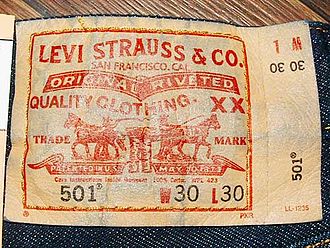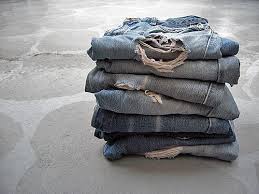British writer Ami Liverton is crazy about jeans. She says half the world’s population wears Denim jeans. It is such an apparel that if worn every day remains useful. It is a helpful and convenient for daily wear for comforts and good look and is fashionable, worn by all the age groups and both sexes. She has written a new book on “Denim Drew dress” and wants to show how attractive people look in this dress.
 Photo Credit: Wikipedia Commons
Photo Credit: Wikipedia Commons
The Jeans came up in USA and is liked and worn all over the world. That’s why from Philippines to Turkey, from Brazil to India, London to Newyork you see people wearing them. Every year around 4000 million pairs gets produced all over the world.
 Photo source : Wikipedia
Photo source : Wikipedia
Jeans are trousers usually made from denim or dungaree cloth. Most of the times, the term “jeans” refers to a particular style of pants, called “blue jeans,”. They were invented by Jacob Davis in 1871 and patented by Davis and Levi Strauss on 23rd May 1873. Starting in the 1950s, jeans, originally designed for cowboys and miners, became popular among teenagers, especially members of the greaser subculture. Via
Historic brands include Levi’s, Lee, and Wrangler. Jeans come in various fits, including skinny, tapered, slim, straight, boot cut, narrow bottom, low waist, anti-fit, and flare. Owing to their high durability as compared to other common fabrics, “distressed” (visibly aged and worn, but still intact and functional) or torn at the knees the jean trousers have become increasingly fashionable, making pre-sale “factory distressing” a common feature in commercially-sold jeans.Via . Jeans are now a very popular article of casual dress all around the world. They come in many styles and colors. However, blue jeans are particularly identified with US culture.
Jean fabric

Research on the trade of jean material shows that it emerged in the cities of Genoa, Italy, and Nimes, France. Gênes, the French word for Genoa, may be the origin of the word “jeans”. In Nimes, weavers tried to reproduce jean but instead developed a similar twill fabric that became known as denim, from de Nimes, meaning “from Nimes”. Genoa’s Jean was a fustian textile of “medium quality and of reasonable cost”, very similar to cotton corduroy for which Genoa was famous and was “used for work clothes, in general”. Nimes’s “denim” was coarser, considered higher quality and was used “for over garments such as smocks or overalls“. Nearly all Indigo, needed for dying, came from indigo bush plantations in India until the late 19th century. It was replaced by indigo synthesis method developed in Germany.Via

Photo credit: gogreenamericatv.com
Initially, jeans were simply sturdy trousers were worn by factory workers. During this period, men’s jeans had the zipper down the front because women’s jeans had the zipper down the left side. Fewer jeans were made during World War II, but ‘waist overalls’ were introduced to the world by US soldiers, who sometimes wore them off duty. By the 1960s, both men’s and women’s jeans had the zipper down the front. Historic photographs indicate that in the decades before they became a staple of fashion, jeans fit quite loosely, much like a pair of bib overalls without the bib. Indeed, until 1960, Levi Strauss called its flagship product “waist overalls” rather than “jeans”.Via
After James Dean had popularized them in the movie Rebel Without a Cause, wearing, jeans became a symbol of youth rebellion during the 1950s. Because of this, they were sometimes banned in theaters, restaurants, and schools. During the 1960s, the wearing of jeans became more acceptable, and by the 1970s it had become general fashion in the United States for casual wear.Via

Photo credit:dorinhawa.com
Michael Bellomo, editor of Sportswear International Magazine, Oct/Nov 1987, P. 45, wrote that in 1965, Limbo, a boutique in the New York East Village, was “the first retailer to wash a new pair of jeans to get a used, worn effect, and the idea became a hit.” He continued, ” hired East Village artists to embellish the jeans with patches, decals, and other touches, and sold them for $200.” In the early 1980s, the denim industry introduced the stone washing technique developed by GWG also known as “Great Western Garment Co.” Via
Donald Freeland of Edmonton, Alberta pioneered the method, which helped to bring denim to a larger and more versatile market. Acceptance of jeans continued through the 1980s and 1990s to the point where jeans are, in the first decade of 21st century, a wardrobe staple, with the average North American owning seven pairs. Currently, jeans may be seen worn by people of all genders and ages. Via










2 Responses
Nicely written and I congratulate you on your crediting sources.
Very informative and nice pictures.
I did not realize even back in the 60’s jeans were selling for over $200
Hi. Im Mohamead.Please l Want to buy Jeans fabric.